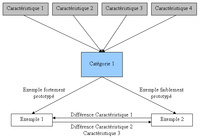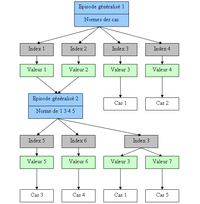
Back المنطق المعتمد على الحالة Arabic Raonament basat en casos Catalan Fallbasiertes Schließen German Kazo-bazita konkludado Esperanto Razonamiento basado en casos Spanish استدلال مبتنی بر مورد Persian Raisonnement à partir de cas French दृष्टांत आधारित तर्कणा Hindi Ragionamento basato su casi Italian 事例ベース推論 Japanese
This article may be confusing or unclear to readers. In particular, the article doesn't describe case-based reasoning from a technical point of view, leaving readers uncertain about how programmers actually implement it. (December 2021) |
In artificial intelligence and philosophy[verification needed], case-based reasoning (CBR), broadly construed, is the process of solving new problems based on the solutions of similar past problems.[1][2]
In everyday life, an auto mechanic who fixes an engine by recalling another car that exhibited similar symptoms is using case-based reasoning. A lawyer who advocates a particular outcome in a trial based on legal precedents or a judge who creates case law is using case-based reasoning. So, too, an engineer copying working elements of nature (practicing biomimicry) is treating nature as a database of solutions to problems. Case-based reasoning is a prominent type of analogy solution making.
It has been argued[by whom?] that case-based reasoning is not only a powerful method for computer reasoning, but also a pervasive behavior in everyday human problem solving; or, more radically, that all reasoning is based on past cases personally experienced. This view is related to prototype theory, which is most deeply explored in cognitive science.
- ^ Kolodner, Janet L. "An introduction to case-based reasoning." Artificial intelligence review 6.1 (1992): 3-34.
- ^ Weir, B. S. (1988). Proceedings of the Second International Conference on Quantitative Genetics (p. 537). Sinauer Associates.


